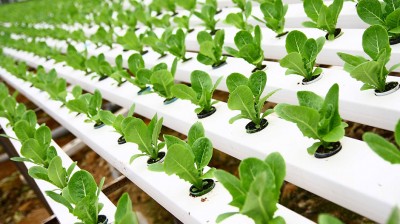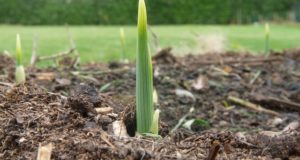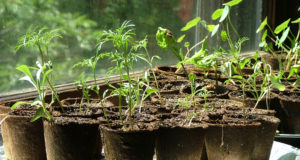
Image source: https://plantasticplantproducts.com
Hydroponics and aquaponics are both soilless agricultural systems that give significantly high yields with minimum inputs. By completely
eliminating soil as a growing medium for plants, and by avoiding wastage of water into the ground, these intensive methods make localized food production sustainable and profitable, in spite of scarcity of water and fertile land.
Hydroponics
Hydroponics is a time-tested method widely used for growing tomatoes and lettuce in greenhouses. The plants are grown directly in a water-based solution containing all the essential nutrients required by them. Inert media like pebbles or clay pellets are sometimes used for supporting the plants. The absence of soil completely eliminates disease-causing soil organisms and weeds. Consequently, labor, as well as the use of use of herbicides, is greatly reduced. The controlled environment protects the crop from most of the air-borne pests. Occasional infestations and fungal infections can be tackled effectively by targeted use of pesticides and fungicides.
Hydroponics typically uses only 20 percent of the water required for traditional cultivation. Periodical replacement of the nutrients-depleted water is the main recurring cost. Electrical conductivity of the solution is monitored daily to maintain optimum nutrient levels. The solution has to be changed when chemical imbalance is detected. Energy requirements include the aeration and pumping of the solution every 4 to 6 hours. Hydroponic culture can be done indoors under artificial lighting, but, while it makes year-round production of food possible, it pushes up the energy bill.
Aquaponics
Aquaponics is a complex cultural method that evolved as an effective solution for the recycling of the waste generated in aquaculture. Based on the wetland ecosystem in which plants and animals support each other, the nitrogenous waste produced in the aquaculture of fish, prawns or clams is used as fertilizer for plants grown hydroponically. Aquaponics enlists the help of nitrogen-fixing bacteria and worms to breakdown the fish waste into nitrates and nitrites that can be absorbed by the plants. The resulting clean water is then recirculated into the aquaculture tank.
The main input in an aquaponic system is fish food besides the power for the running of the electric pumps that recirculate the water round the clock. Since the water loss, mainly from transpiration by plants and evaporation into the atmosphere, is minimal, replenishment is needed very rarely. This reduces the water requirement of aquaponics to about 2 percent of that of traditional cultivation.
Without A Doubt The Best Kept Secret In Self-Reliance Gardening…
Hydroponics vs. Aquaponics
Even though both the methods qualify as high-yielding systems that maximize space utilization and considerably reduce the dependency on water, each system has certain advantages and disadvantages:
- Energy requirement. Power is required to run the aerators and pumps that keep both the hydroponic and aquaponic systems running. Daily power expenditure is higher in aquaponics with its frequent water circulation. However, it is easily offset by the higher returns from both the fish and the plant crops.
- Waste disposal. Periodic replacement of the hydroponic solution results in large amounts of waste water. Disposal of this fertilizer-rich water into natural water bodies is an environmental risk. It can promote algal growth and be a threat to aquatic ecosystems. In aquaponics, solid waste generated by the fish in excess of what gets broken down by the worms and bacteria is the only waste. Since it is organic in nature, it can be disposed of into the common drain or used for composting.
- Monoculture and the risk of diseases. In hydroponics, the liquid medium for each crop is specifically formulated to meet its specific nutritional requirements; hence, monoculture is preferred for the maximum utilization of the fertilizer input. Disease risk, especially from fungal infections, is higher in hydroponics; and an outbreak can spoil the entire batch. Hence, special measures are taken to protect the crops from contamination. Fish waste being a general organic fertilizer, a variety of plants can be grown together in aquaponics. In a well-established system, the different components such as fish, worms, plants and various bacteria form a natural ecosystem that resists diseases.
- Necessity of solid growing media Solid media can be completely eliminated in hydroponics; its only function is providing an anchor for the plants. When pebbles or clay balls are used, 6-inch deep beds are the norm. Aquaponics also does away with soil, but other coarse media like clay pellets or rock pieces are used to provide a home for the beneficial bacteria similar to the ones that exist in the soil. Waste-eating germs also thrive among the solid media. To sustain these organisms, 12” deep beds are recommended.
- Time delay for the maturing of the system: Hydroponic units can be set up quickly and start running without any gestation period. Yield is determined solely by the normal growth period of the given crop. The complex set up of aquaponic system requires a maturation period to become functional. The establishment of bacterial colonies for the effective breakdown of the fish waste is an indispensable part of aquaponics. It can take 3-6 months.
- Risk of loss in case of mechanical failure: No mechanical system is fail-proof. Electrical failure, mechanical faults, blockages in the plumbing and malfunctioning of monitoring devices, can affect the system adversely. In hydroponics, most problems can be resolved immediately without causing lasting damage, as it has a 5-6 hour flood-drain cycle. Aquaponics has very short recirculation cycles, once every 30 to 45 minutes, so the cost of even temporary failure can be particularly high, often resulting in the loss of the entire fish stock due to toxic chemical build-up in the aquaculture tank. The solid waste produced by the fish make the system comparatively more prone to blockages too.
- Chemical control of pests and addition of nutrients. An outbreak of pests or infections in hydroponically grown crops can be quickly controlled by spraying the crops with appropriate pesticides or fungicides. Any nutritional deficiencies spotted in a crop can be rectified by adding the required fertilizer into the growing media. Any addition of chemicals to an aquaponic system entails careful consideration, as it can upset anyone of the different components such as fish, bacteria and worms. Iron deficiency can be usually tackled by supplementation, but pests have to be controlled mechanically.
Story continues below video
The bottom line
Easily set up indoors or outdoors, hydroponic units can be run successfully by following the instructions such as daily testing of the electrical conductivity and responding to changes in the prescribed way. Since it does not require additional expertise, even a novice can have excellent results.
Being the more sustainable and profitable system of food generation, aquaponics is the future of alternative agriculture. Even though the initial cost of setting up a complete system is higher, once established, it runs like clockwork with minimal recurring inputs.
Imbalances in an aquaponic system are rectified by adding either more fish to meet additional demand for nutrients, or more plants for enhanced cleaning of the water. Thorough understanding of the symbiotic relationship between all the components is necessary to take appropriate decisions.
 Off The Grid News Better Ideas For Off The Grid Living
Off The Grid News Better Ideas For Off The Grid Living




